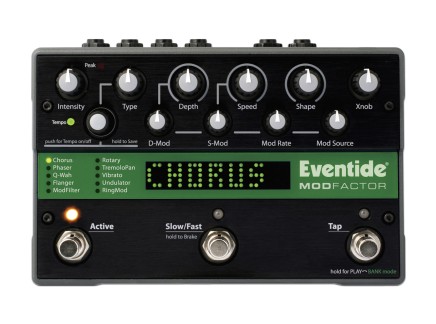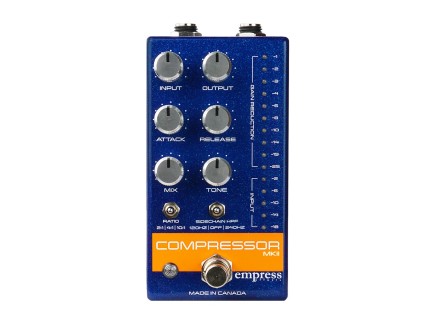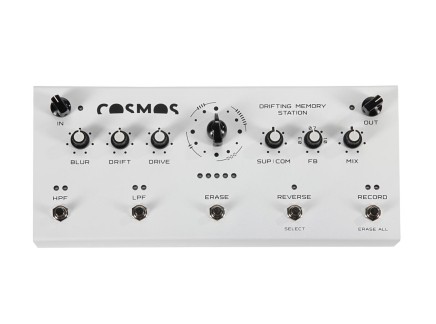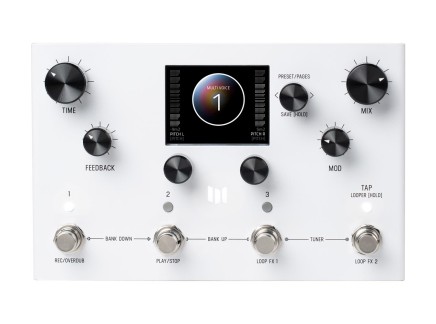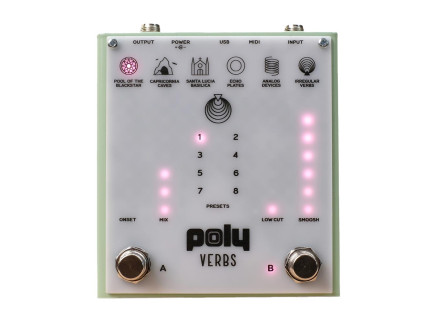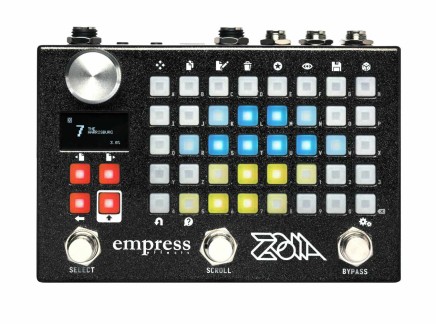Ambient music is one of the best genres for guitar players. Its combination of lush, expansive arrangements that tend to require massive amounts of gear and focus on deliberately crafted passages provide a multitude of ways for guitarists to show the prowess they’ve worked so hard to achieve.
Building the best pedalboard for ambient music takes a different strategy than other genres. The musical style requires experimentation with your tone, and what guitarist doesn’t love that? So let’s explore some of the different categories of guitar pedals and some key options that let you craft the sounds in your head and bring them to life.
What is Ambient Music?
Ambient music is a versatile and often misunderstood genre. At its core it’s a style that’s tailored to create atmospheric soundscapes that immerse the listener. While it certainly stands on its own, it’s a subgenre of a lot of different styles like rock, pop, even modern country. (Note: check out our article Perspectives on Ambient Music for greater detail on this difficult-to-define genre.)
When it comes to the role the guitar plays in ambient music, it’s pretty much entirely open ended. While the guitar is relegated to specific roles in most styles of music, when it comes to building a pedalboard for ambient music there are literally no rules. If it sounds good, it is good!
Best Types of Guitar Pedals for Ambient Music
Ambient music is a guitar player’s dream, because the rules that tend to bind the sounds of most genres don’t really apply. Their creativity can run wild, and with it the way they design their rig.
Let’s go over some of the best effects categories for ambient music and why they fit so well into the equation.
Time-Based Effects
Time-based effects like delays and reverbs are one of the cornerstones of ambient music. They're ideal for building out the lush, atmospheric guitar sounds that are cornerstones of the genre.
Delays come in a wide variety of categories, from more traditional analog and digital models like the JAM Pedals Delay Llama Mk3 and BOSS DD-8 to full-featured creation workstations like the Strymon TimeLine or Meris LVX modular delay system. And when it comes to reverbs there are simple options like the JHS 3 Series Reverb to the advanced, venerated models in the Strymon BigSky, Nightsky, or MercuryX modular reverb pedal.
Time-based effects also blend well with pretty much every other type of effect, allowing you to stack sounds at will to create all kinds of dimension and space.
Modulation Effects
Modulation effects are another go-to category when building a pedalboard for ambient music. It's one of the most broad, with popular professors like phasers, flangers, and chorus being the most familiar. But it doesn't stop there. You'll also find vibrato, tremolo, and similar effects on the pedal boards and on the amplifiers of a lot of ambient guitar players.
Considering the atmospheric nature of ambient music, the sense of movement that modulation effects provide make them for the genre. And just like delays and reverbs, they tend to sonically stack very well with other types of effects.
Sure, you can keep things simple by going with tried and true options like the MXR Phase 90 phaser or the Electro-Harmonix Electric Mistress flanger, but where’s the fun in that? If you’re looking to branch out, something like the Alexander Pedals Neo-Matic or Death By Audio Space Bender provide next generation creative options. And if you want an all-in-one solution, something like the Eventide ModFactor might be the perfect choice.
Gain Pedals
Gain pedals are one of the staples of pretty much any pedal board. Even if players are getting their gain from the amp, gain pedals provide a number of uses from adding additional saturation and sustain, to a signal boost, to reshaping the overall EQ profile.
When it comes to ambient music, gain pedals are generally utilized for adding sustain to single note and lead lines as well as providing some warm crunch for rhythm parts. But with so many options to choose from, how do you find the gain pedals that best suit your sound?
It depends on the sound you’re chasing. If you just need to add some subtle crunch then a Tubescreamer-style pedal does wonders. The JAM Pedals Tubedreamer or JHS Pedals Superbolt V2 are terrific choices.
If you need more available gain, a crunchier alternative like the MXR M75 Super Badass Distortion or Empress Effects Heavy Menace are just a couple available options. Fuzz pedals are also right at home on a pedalboard for ambient music, and the ZVEX Fuzz Factory is one of the best. And if you need something altogether unique, you should check out the Old Blood Beam Splitter, a peculiar gain pedal + delay combo designed for building larger-than-life textures.
Regardless of your favorite flavor when it comes to gain pedals, they are a centerpoint for all types of guitar sounds. And for such a seemingly simple effect they can drastically shape your sound in a multitude of ways.
EQ
EQ pedals tend to be the unsung heroes of any pedalboard signal chain. And considering the tonal avenues they open up it's a shame they don't get more respect. They can be used in a number of creative ways from augmenting the EQ controls on any type of amplifier, changing the overall frequency image of the guitar, or as a clean or frequency-dependent boost.
If you just need a workhorse equalizer pedal the MXR M108S graphic EQ is one of the most popular. Then there are more sophisticated options like the Empress Effects ParaEQ MKII or Jackson Audio Bloom V2 that adds in compression options.
Dynamics
The dynamics category of guitar pedals can technically cover anything from overdrives to filters, but here we’re specifically talking about circuits that provide a detailed level of control over the signal like compressors, filters, and noise gates. If there’s one adjective you can use to describe ambient guitar-based music it’s dynamic. And as such it’s important to consider the different types of dynamics control pedals available when building a pedal board for ambient music.
Compressors are the most common type of dynamics effect (other than overdrive and distortion pedals, but semantics…). Just like studio compressors they come in a variety of flavors and range from simple to complex. The JAM Pedals Dyna-ssoR provides a very “obvious” style of signal squish, and the Empress Effects Compressor MKII sports a full-featured control set that lets you dial in the exact amount of compression you need and has LED metering.
If you use a lot of gain and want to cut out noise the Electro-Harmonix Silencer and MXR M135 Smart Gate work well. Dynamics pedals offer good control over the dynamic envelope of your signal and go far in helping to keep the articulation of your playing and other pedals in check.
Harmonizers and Pitch Shifters
Now we're getting to the good stuff! Pedals that manipulate the pitch of the guitar signal are some of the most creative and fun to experiment with. These types of pedals have gotten a lot more sophisticated in recent years with features like polyphony and flawless tracking.
The Electro-Harmonix POG is one of the premier pitch shifter pedals that has controls for an octave up and down. And the Meris Hedra is a rhythmic pitch shifter with a tap tempo footswitch. When it comes to harmonizers, the Eventide H90 is a multi-effect from the company that created the concept in the first place, and the BOSS PS-6 Harmonist offers many useful settings.
Harmonizers and pitch shifters are right at home on an ambient pedalboard and are especially useful if you’re the only guitar player in the band—allowing you to transform your single instrument's sound into vast, multi-voice textures.
Loopers
There are so many ways to use a looper pedal—especially for ambient music. What's more is they can be used on guitar, bass, and even vocals! Some come with line and mic level inputs, some might need signal impedance conversion to use with a microphone.
Stack your parts with the Electro-Harmonix 95000 looping workstation or the simple but effective BOSS RC-1 Loop Station, a smaller version of their RC line. Loopers let you pile different parts on top of each other, opening up new worlds of sounds that are perfect for ambient music.
Overlooked Ambient Pedals
With so many different types of guitar effects on the market it’s understandable that some may fly under the radar or get overlooked altogether.
As one of the most revolutionary guitar effects of all time, saying that the Eventide Harmonizer was a game changer when the first model, the H910, was released in 1975. As mentioned above, the Eventide H90 is a modern version of their famous Harmonizer line that offers all kinds of pitch shifting and modulation settings. It can do a lot—vast reverbs, delays, modulation, pitch shifting, and much, much more.
With the rise of boutique effects pedal manufacturers over the last few decades the guitar community was introduced to sound concepts that the larger builders felt were too esoteric to have mass appeal.
Meris is a perfect example of a company whose effects pedals are perfect for the sounds of ambient, guitar-based music. Their Meris Mercury7 Ethereal Stereo Reverb is an ambient guitarist's dream with controls over modulation and pitch. Meris also offers plenty of other pedals perfect for building a pedal board for ambient music like the Meris Enzo stereo synthesizer that’s great for replicating keyboard sounds, the Hedra Rhythmic Pitch Shifter that follows playing articulation fabulously, and the LVX Modular Delay that goes way beyond a normal style of delay.
Earthquaker Devices offers some unique circuits as well. The Organizer V2 is a polyphonic organ emulator, the Hummingbird V4 is an interesting take on tremolo, the Afterneath is a unique reverb with an innovative control set that’s caught on with a lot of professional guitarists even outside of ambient styles.
Signal Flow and Pedal Order
With a complex effects pedal chain comes having to manage the signal flow and pedal order. There is no “right” way to order your pedals, but there are some suggestions for best practices.
In general, it’s best to have pedals that sound best without buffers before them first in line. This includes wah and volume pedals as well as certain types of fuzz boxes. Gain-based pedals like overdrives, distortions, and compressors come next. Modulation, pitch shifters and harmonizers work well after them, and delays and reverbs usually provide the best results last in line before the signal hits the amp.
Luckily there are multiple signal routing tools that help you organize your signal flow, make switching between effects easier, and even set up presets with different combinations of effects.
The Earthquaker Devices Swiss Things is a compact signal router that gives you two effects loops, A/B switching, and a boost. You can also go for a loop switcher like the Voodoo Lab PX-8. Loop switchers offer multiple ways to set up your signal flow and different effects patches so they are available through a centralized control system. This means you can have a complex signal flow and engage multiple pedals at once without having to tap dance all over the place.
Organization, Power, and Cabling
Building a pedalboard for ambient music isn’t just about choosing the right effects pedals. You also need to consider the pedalboard that houses them, the power supply that juices them, and the cabling that connects them.
Pedalboard
Your choice of pedalboard is just as important as the pedals that will go on it. If you have a smaller setup of deliberately selected pedals a board like the Voodoo Lab Dingbat Small or PedalTrain Classic 2 SC might provide enough real estate.
If you’re still building out your signal chain or have plans for continuous expansion you want a pedalboard that accomodates that. Alot of ambient guitarists either have a large pedal count or plan on getting there one day you’ll want to opt for something larger like the Voodoo Lab Dingbat PX or the D’Addario XPND 2 which offers a slider extension so you can tailor the footprint to different sizes as needed.
Power Supply
Ambient music is a guitar geek’s dream, and the bigger the pedal board the more fun you can have! But while larger pedal counts offer a better variety of sounds, they also introduce potential complications that need to be considered.
Pedals can take different levels of voltages, so the type of guitar pedal power supply you choose is important. And if you’re running a lot of pedals, you’ll need more than one. Sure, you can run some of the 9V pedals on batteries, but that introduces the headache of monitoring their charge levels and having mismatched voltages compared to the pedals connected to a power supply.
For smaller signal chains something like the Voodoo Lab Pedal Power 4x4 or Eventide PowerMini are great choices. If you have a pedal chain that needs varying voltage levels you can’t go wrong with the Stymon Zuma.
Cabling
In theory cabling is a simple concept, but there are many ways it can introduce complications - especially for larger pedalboards. One of the reasons is that pedal layout doesn’t always correspond with signal flow. A lot of guitar players arrange their pedals by convenience and not order. This means that standard 3”or 6” connector cables might not always provide enough length. You could also go in on solderless patch cables so you can create the specific lengths your pedalboard needs without the headache and tools required to create them the old fashioned way.
The Amplifier's Role
This article is focused around building a pedalboard board for ambient music, but it's important to touch on the critical role the amplifier plays in the sound equation too. Since the pedal chain will flow into whatever type of amp you're using this could factor into purchase decisions as not all pedals play nice with every type of amplifier.
Regardless of the style of amp you prefer, as long as it's a good quality you shouldn't be too concerned about it not working well in the overall context of your guitar tone.
Conclusion
Ambient music is a genre that's perfect for guitar players who love to experiment with sounds. All types of effects pedals are fair game, from the familiar to the most esoteric.
When it really comes down to it, building a pedalboard board for ambient music is all about the journey of discovery. Trying out different types and models of effects, designing the signal chain, and laying out the pedalboard with power and cabling.
Ambient music is an experiment in discovering new sounds, and just like the style itself designing the perfect pedalboard for should be too.


